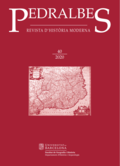Mediterranean trade in the Pyrenees: Italian merchants in Puigcerdà, 1300-1360.
DOI:
https://doi.org/10.1344/PEDRALBES2020.40.2Keywords:
woad, cloth dyes, Italians, Mediterranean, merchants, Puigcerdà, Pyrenees, cloth industryAbstract
Based on an examination of surviving notarial evidence from the Pyrenean town of Puigcerdà, this article investigates the ties between the inland mountainous regions of the Mediterranean and broader Mediterranean trade net- works in the later Middle Ages. It shows that, following the rapid expansion of cloth production in the Catalan Pyrenees during the late thirteenth century, Italian (mainly Tuscan) merchants, some themselves from smaller interior towns, began travelling not only to the major Mediterranean coastal ports but also, through them, into the inner Catalan Pyrenees, where they sold cloth-dyeing materials from at least 1302 on. The commercial activity of these merchants appears to have grown during the first decades of the fourteenth century as cloth production in Puigcerdà continued to grow and persisted at least into the 1360s. Through a comparison between the number of Italian merchants operating in Puigcerdà and those in the smaller Catalan town of Castelló d’Empúries, this article also reveals that the level of access to Mediterranean products and trade in inland mountainous regions was significantly lower than that of the coast. Both towns appear to have been part of one interconnected network that saw some of the same merchants trading in Puigcerdà and in Castelló. This network was likely based in Perpignan, where a high number of the Italian merchants resided. The number of Italian dyesellers in coastal Castelló far outstripped those in Puigcerdà, suggesting that while the inner Pyrenees were tied to Mediterranean trade, these economic connections were less dense than those in coastal areas, and more limited by local geography.
Downloads
Published
How to Cite
Issue
Section
License
Copyright (c) 2020 Elizabeth Comuzzi

This work is licensed under a Creative Commons Attribution-ShareAlike 4.0 International License.
Authors must agree with the following terms:
1. The author keeps authorship rights, ceding the journal the right to first publication.
2. Texts will be disseminated with a Creative Commons Attribution 4.0 International License. Which allows for the work to be shared with third parties, as long as they recognise the work’s authorship, the original publication in the journal and licensing conditions.
This requires acknowledging authorship appropriately, providing a link to the license, and indicating if any changes have been made. It can be indicated in any reasonable way, but not in a manner that suggests the licensor endorses or sponsors the use of the text.
If content is remixed, transformed, or new content is created from the journal's texts, it must be distributed under the same license as the original text



